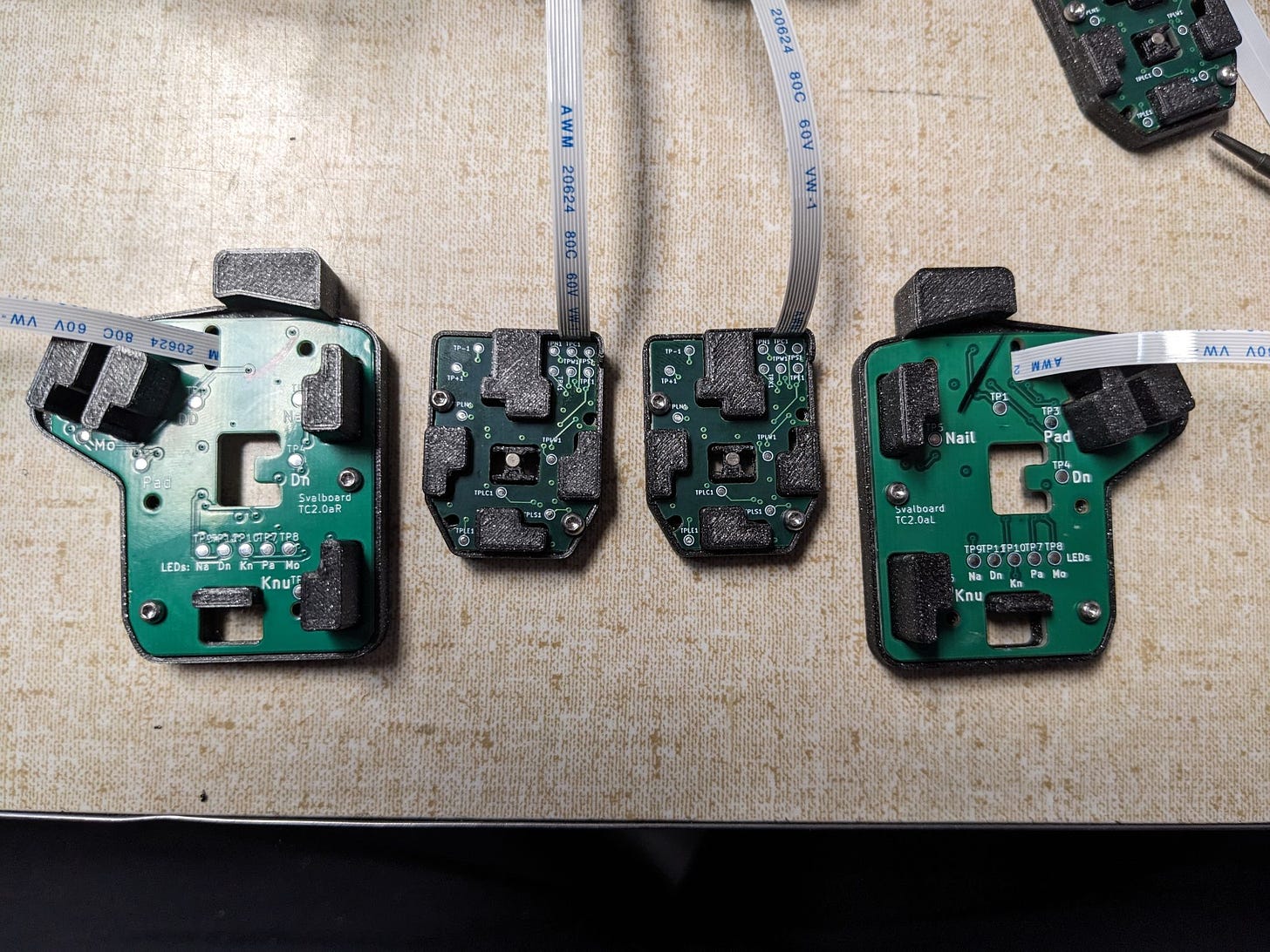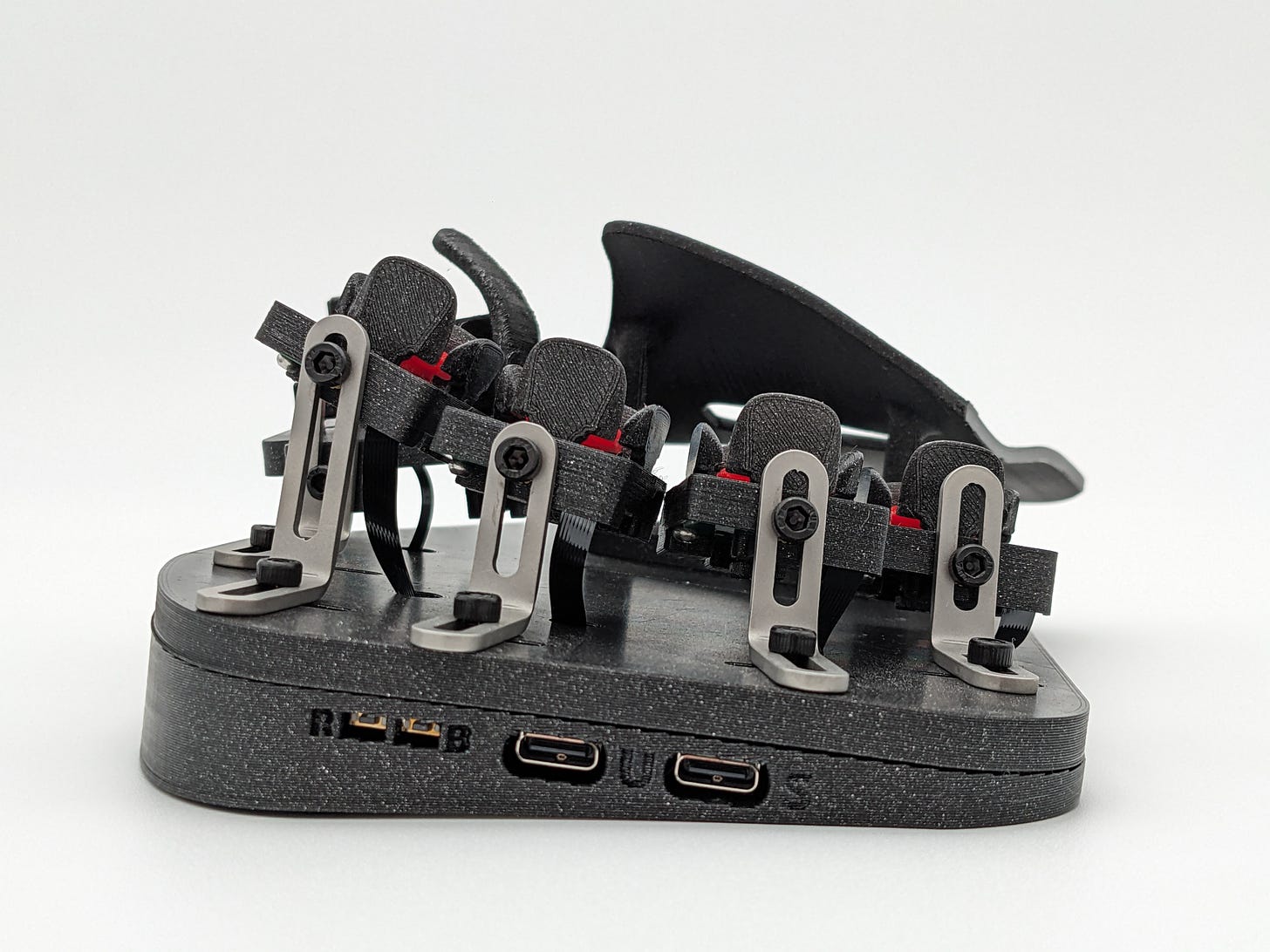One of the ironic things about developing keyboards for a living is that the assembly process is quite likely to give you RSI.
Since I started Svalboard, I've probably manually screwed in almost 10,000 M2 T-6 screws into plastic to hold PCBs down, and probably about 10,000 M3 screws for cases and adjustable cluster mounts.
It's done in short spurts of work and not too much at any given time, so I haven't really suffered from it, but I can start to feel my shoulder telling me that it's time to change.
Very few people are actually familiar with how assembly is done in a factory. It's a fascinating science, and it's all about driving speed and productivity while protecting people from overuse injuries that cost you valuable training time to find replacement workers… :P
It's frankly a little bit silly that I've waited this long, but I'm kind of cheap [and stupid?] at heart.
So recently I decided to take a trip down the Alibaba rabbit hole and procure some specialty assembly equipment to help make my life easier. In this post I'll talk about what I bought, how it's working, and how much it's changed my throughput and comfort.
The first step I took was to get some screw presenters. For the first 30 units or so, I was literally picking up every individual screw with my fingers, putting it on the tip of a screwdriver, and putting it in manually.
This was a big step up because now I could just reach over with the screwdriver and pick up a screw directly without having to think about it. But it didn't solve the overall problem of driving screws manually.
It’s not like electric screwdrivers are hard to find, but the ones you have sitting around your house don't have torque limits that are appropriate for tiny things like this. I tried out some Amazon options that had a degree of torque limiting, but they're all dedicated to consumer electronics repair, and they don't fit easily into screw presenters, and they’re not really that ergonomically designed.
So recently, I decided to help my shoulders out and ordered a couple of overhead balanced screwdriver arms with custom electric torque screwdrivers especially designed for the specific fasteners I’m using. These also have vacuum pickup so that you can grab both stainless and regular steel fasteners, regardless of magnetic properties.
I also ordered spring-balanced driver arms, which allow the driver to float at a neutral height so you use the stronger, more robust pulling muscles in your arms for insertion, rather than carrying the weight of the driver around:
These videos are all from the manufacturer demonstrating my setup, which they pre-tuned perfectly. Very nice customer service from Fuyuantech — they sourced samples of screws from my supplier, custom built the vacuum setups to accommodate them perfectly and did full testing before shipment.
With an M2 T6 driver and an M3 T10 driver, I’m now down to two screw sizes, and my productivity is ridiculously improved. I think the total time to assemble PCBs to plastics was cut by 75%, though I’m not tracking precisely.
Frickin’ DUH, Morgan. I mean, it’s not like I’ve ever set up a factory to build tiny things before… :P
And the time to assemble the tower brackets that hold the key clusters, as well as case closure, has also decreased similarly. This is a major portion of the overall assembly process, with the balance being the assembly of magnets into keys, for which I already do a *lot* of fixturing. Once again, the joy of 3D printing is that precise fixturing becomes a trivial exercise:
One thing that's really great about this approach is that I still have flexibility if I need to change what screws I use, just a few small custom parts to change.
The ultimate version of this would be a tube-fed screw gun so that there's no more pickup step. I think that would actually cut another seventy-five percent of the working time out of the process, but it’s not worth the space right now, and I’d need two, which is *very* bulky for my small workspace, plus they’re way more difficult to refit for different screws.
If I make it to true medium volume manufacturing, I have two choices: one is to go to China the way I know how, and let other people do the optimization of labor versus tooling. The other is to try and keep things domestic so that they stay under my control, and I can iterate more quickly and at lower cost.
The tradeoff between low-cost labor and low-cost iteration is critical, and at the moment I prefer the flexibility in design. That said, when you do all your assembly locally for control and flexibility, you have to hire and manage local labor, which is extremely risky in the United States. The burdens on small employers in terms of just tracking payroll and tax stuff are horrific, especially in California. Just being a sole proprietor is a major PITA, honestly.
I'm kind of shocked that anybody operates ANY low-margin small business. Can you imagine running a restaurant for a 3% return on capital? Aaaaaaaaackk!
What I’m doing here is way more esoteric, but way less HARD than managing a restaurant…
Anyway, hope that’s an interesting little window into the process! Don’t forget to mention Svalboard to the typists in your life :)
Reminder:
Svalboard is a completely independent product development enterprise with no investors — 100% bootstrapped innovation and honest product development led by me, a passionate industry veteran who’s tired of ad businesses — and assisted by a few incredibly good-natured volunteers. Our goal is to help people live free from pain.
Your support, and especially your help getting the word out about the product to people who suffer with *or treat* RSI is essential. If you know someone who suffers with RSI, or who wants to ensure that they don’t someday — PLEASE tell them about it and send them to the the Discord to learn more.
If you want to support Svalboard financially, buy a sample cluster or a beer on the shop, or consider taking the plunge on a Lightly - the return policy is phenomenal, and the customer service rep is, like, SUPER handsome.








And we take this all for granted!